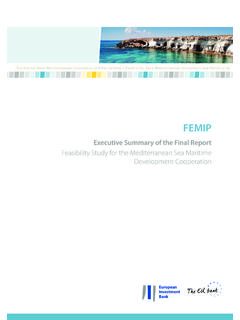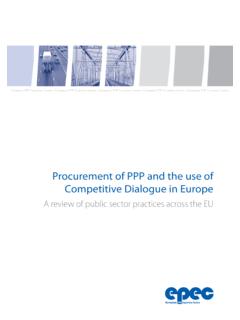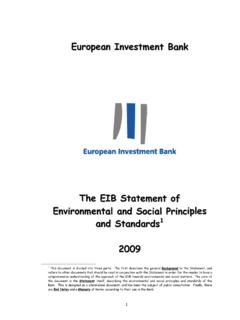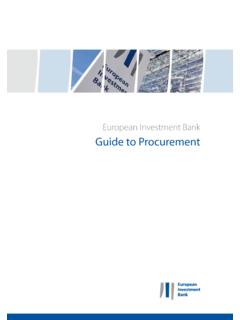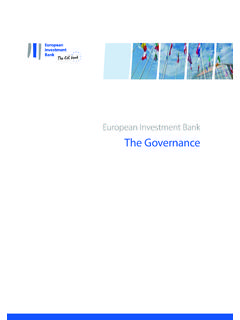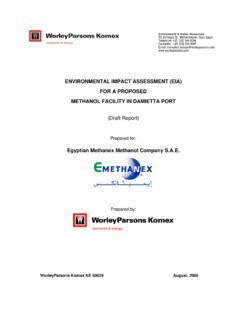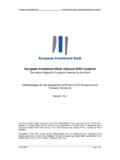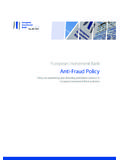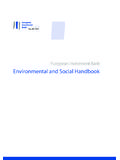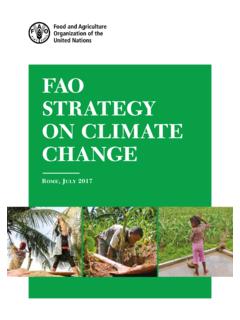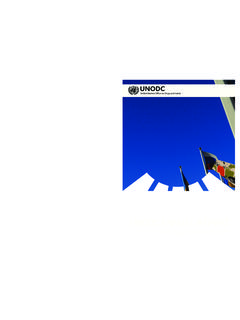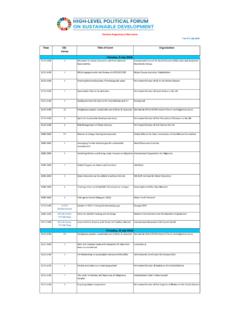Transcription of The EIB outside the EU – 2016 Report
1 EIB05/2017print:QH-AU-17-001-EN-CISBN978 -92-861-3238-4 ISSN2363-0272 EIB GraphicTeamdigital:QH-AU-17-001-EN-NISBN 978-92-861-3237-7 ISSN2363-0280 EIB outside the EUDelivering on EU policiesReporting on results 2 Foreword by the President 4 Introduction New projects financed in 2016 Promoting environmental and social standards 11 Contributing to the Sustainable Development Goals 16 Action on climate change 22 Migration reaping the benefits and addressing the challenges 26 Focusing on impact32 Beyond what local markets offer the EIB contribution 38 In detail lending in 2016 Supporting local private sector development Developing social and economic infrastructure 56 Looking back: Results of completed ReM Framework operations 60 Annexes Annex 1: Mainstreaming climate action Annex 2: 2016 aggregate lending volumes Annex 3: How we measure results Annex 4: ReM Framework ratings Annex 5: List of projects signed in 2016 Annex 6: Tables, figures and boxesContents12016 The EIB outside the EUForeword by the PRESIDENTIn times of uncertainty, there can be a great ten-dency to look inward, to focus only on what s happening in our own back yard.
2 But we also live in a time of global challenges and global re-sponsibilities. In a context in which internation-al solidarity and cooperation seems to be under growing threat, it is more important than ever for Europe to continue to play its role as a global lead-er in support of sustainable economic develop-ment and change is one such global challenge. In Eu-rope we have a responsibility not just to reduce our own footprint, but also to help countries with fewer financial resources and technical know-how to follow a more sustainable development path that is also more resilient to the effects of climate change that we are already seeing. Migration is another challenge that calls for urgent large-scale action, not just within Europe but also in our immediate neighbourhood and in other regions from where so many people are driven to seek refuge or the chance for a better life.
3 Both within the EU and elsewhere, we have a responsibility to help refugees and other migrants, and also the societies that host them and that they transit through, which are also of-ten put under considerable strain. We have to address the root causes of migration and the intolerance that migrants face by building up economic resilience and the ability of societies to offer real economic opportu-nities and a dignified life to all. In the face of such challenges, I am very proud that the work of the EIB, as the EU bank, does not just stop at the borders of the EU. We are also the leading part-ner of the EU Member States our shareholders and the European institutions, in using our financial fire-power and technical expertise as the world s largest multilateral lender to support our common efforts to implement EU external policy.
4 Our lending outside the EU comprises about 10% of our total commit-ments; that s some EUR 8bn approved for new pro-jects signed outside the EU in 2016. This lending is expected to bring some very impres-sive results. The projects supported will lead to im-proved access to safe water or better sanitation servic-es for some million people. million households will get new or upgraded electricity connections, while the equivalent of 250 000 households will be supplied with electricity from renewable sources, mit-igating climate change. Investments in better and more sustainable transport systems within and between cities play a major role in our activities, with million passengers set to ben-efit directly from improved public transport services, with many more benefiting from the greater sustain-ability of these transport modes.
5 We estimate that new transport investments outside the EU in 2016 will save some 51 million hours of journey times in to-tal, bringing benefits both in terms of economic effi-ciency and personal well-being in some of the world s busiest cities like Cairo in Egypt and Lucknow in India. Our support for infrastructure development helps to create the conditions for sustainable and inclusive eco-nomic growth. So does our support for local private sector development, for which we use instruments such as credit lines to local banks or microfinance insti-tutions or equity for social impact funds to help ensure that cash-strapped businesses are able to get the long-term financing they need to sustain and create jobs.
6 We expect almost 700 000 jobs to be sustained in this way through credit lines alone. 2 The EIB outside the EU 2016in addressing this challenge in host countries, tran-sit countries and countries of origin. With more than three decades of experience in the region, we are best placed to deliver this financing. Following a call from the European Council, we are developing the Economic Resilience Initiative to increase financing to the EU s neighbouring countries, boost economic resilience and support the achievement of the SDGs as part of the joined up EU response to the challenges posed by forced displacement and migration. At the EIB, we know that what we do outside the EU as part of Europe s global outreach is just as important as what we do inside Europe, helping to tackle some of the great challenges of our age, challenges that we can only overcome by working together.
7 Werner Hoyer In carrying out this lending, we are building on our long track record, but we are also developing the ap-proach we take to respond to the evolving EU and global policy agendas. The Sustainable Development Goals (SDGs) provide a globally agreed framework for assessing our progress in addressing the challenges that we face together as a planet. For the first time this Report discusses how our activities, and the re-sults that we expect to achieve, link up to these SDGs. Alongside a focus on climate action, as in previous years, the Report also looks at the growing role of im-pact financing in what we do. Last, but not least, this year s Report has a special fo-cus on how our activities respond to the issue of mi-gration.
8 As the EU s bank and the largest IFI lender for projects in the pre-accession and MENA regions, the EIB is committed to assisting EU Member States 32016 The EIB outside the EUForeword by the PRESIDENTI ntroductionAs the bank of the European Union, the EIB also has a special role to play outside the Union, supporting the common efforts of EU Member States to advance EU external pol-icy objectives. Among EU institutions we have a unique ability to mobilise financial resources for economically sound projects around the world, whilst our technical expertise helps to ensure that these resources achieve high environmental, so-cial and economic returns.
9 EIB loans can be blend-ed with grants from the European Commission and Member States to provide the right financing mix for projects that could not otherwise go ahead. At the same time, our advisory role ensures that pro-jects are well designed and successfully imple-mented often becoming demonstration projects that can catalyse even greater a time of geopolitical flux, achieving EU policies and contributing to the 2030 Development Agenda will require the concerted efforts of the public and private sectors and civil society. It will require un-precedented public and private investments in basic infrastructure and the provision of essential services, thereby promoting the growth of a vibrant private sector to provide economic opportunities through decent employment and enhanced goals are reflected in the mandate objectives of the EIB under the External Lending Mandate (ELM) and the Cotonou Agreement for the ACP re-gion (Box 1).
10 There are two main objectives: sup-porting local private sector development and the development of social and economic infrastructure. These are complemented by the cross-cutting ob-jectives of climate change mitigation and adapta-tion and regional Annual Report presents EIB activity outside the EU in 2016 and the results this is expected to achieve. These are results we track using the Bank s Results Measurement Framework (Annex 3). As projects that were approved under this framework (introduced in 2012) gradually reach completion, we are also increasingly looking back at the final results EIB outside the EU 2016 The largest number of new projects was in the Africa, Caribbean and Pacific (ACP) region where projects tend to be relatively small in financial terms, although with a strong impact (Figure 1).
